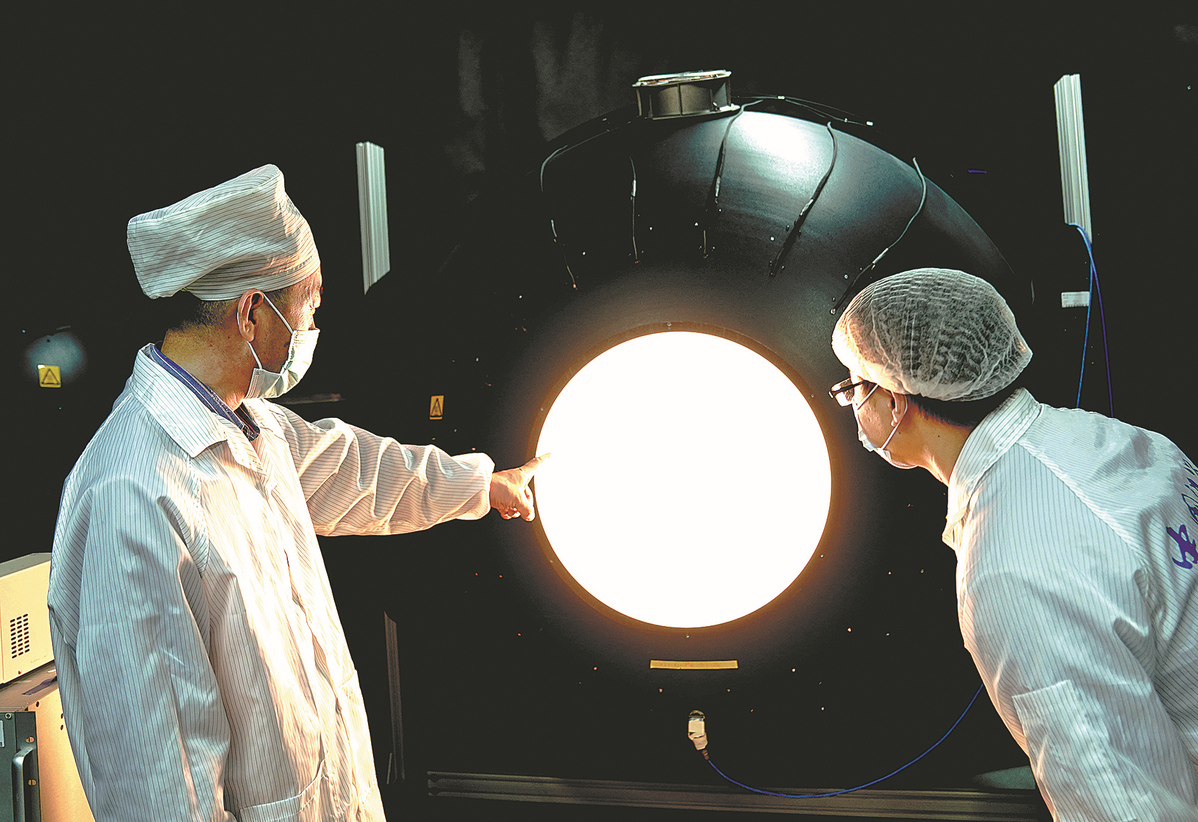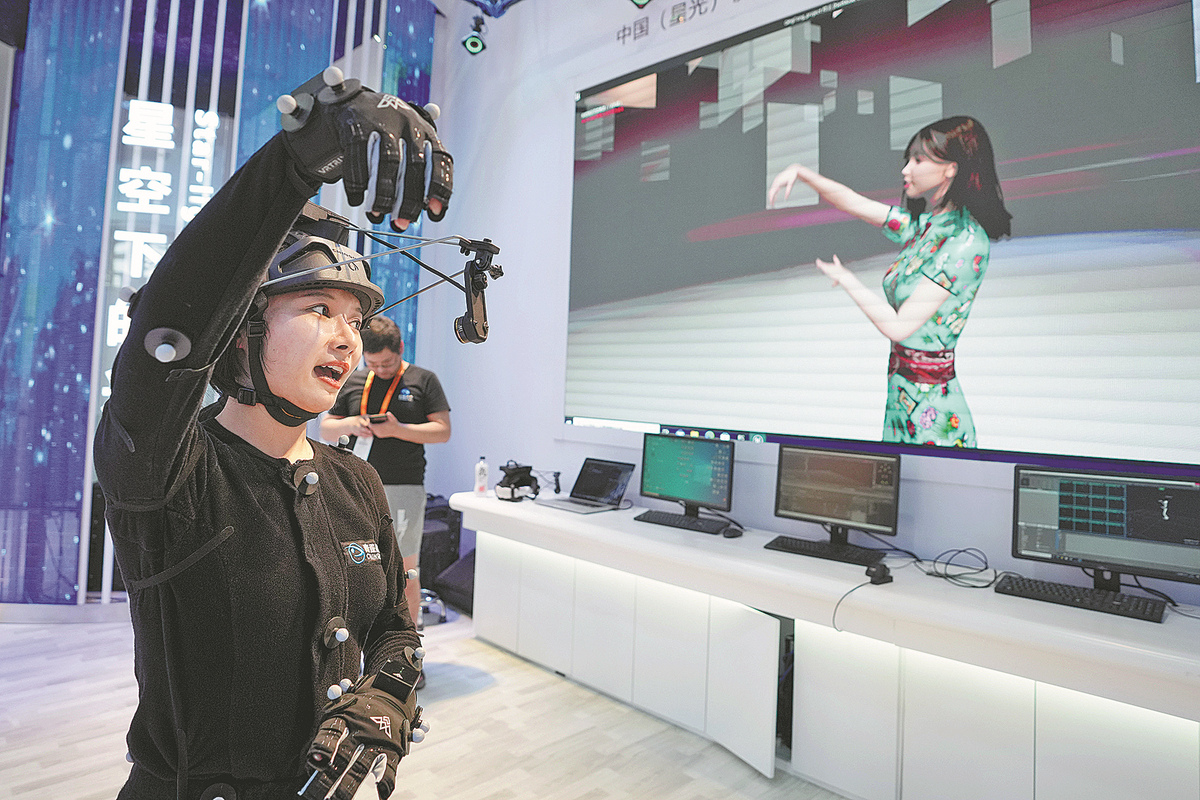

Scientists conduct a solar spectrum experiment at a Chinese Academy of Sciences' laboratory in Shanghai. ZHANG JIANSONG/XINHUA
Chinese cities, led by metropolises such as Beijing and Shanghai, have shown their strengths in science and technology innovation in recent years, increasing their international influence and attracting additional talent.
Beijing ranks first globally on a list of cities for scientific research output, according to the Nature Index 2022 Science Cities supplement released in late November. It is the sixth consecutive year the Chinese capital has ranked top since it surpassed New York for the first time in 2016.
Released by Nature Portfolio, a branch of the internationally renowned science and technology publishing agency Springer Nature, the Nature Index tracks research output published in 82 top-notch natural science journals.
Along with related agencies, it presents an overall view of high-quality global research output and cooperation.
Beijing takes up nearly one-fifth of national research output in the Nature Index. Among the top 500 research agencies in the world, 23 are located in Beijing, 14 in New York, 12 in Shanghai, seven in Boston, and six in the San Francisco Bay Area.
The capital is also the largest inter-city scientific research center for cooperation in China. Most important scientific research cooperation is carried out in Beijing, which is also an essential partner to many cities in terms of cooperative relationships.

Scientists study molecules at a Chinese Academy of Sciences' laboratory in Shanghai. ZHANG JIANSONG/XINHUA
Rapid progress
Beijing is home to the first high-tech park in China — Zhongguancun Science Park. The venue boasts dozens of universities, including Tsinghua University, numerous research institutions affiliated to the Chinese Academy of Sciences, and some 300 research and development, or R&D, centers for multinational companies.
Caroline Wagner, a science policy researcher at Ohio State University in Columbus, United States, said industries, universities and government institutions have gathered together to form a feedback loop. This feedback system accelerates the creation of scientific knowledge and pushes more scientific research to the forefront.
According to official statistics, the number of R&D personnel in Beijing last year reached 338,000, with 76,000 engaged in basic research. The overall scale and quality of scientific talent in the capital continues to rise.
Xu Qiang, director of Zhongguancun Management Committee, said Beijing has the strongest science and technology foundation and the most concentrated innovation resources in China.
"In recent years, Beijing's strategic scientific and technological forces have made landmark achievements. Related reform has achieved breakthrough progress," he said.
"Next, Beijing will focus on training and gathering strategic scientists and young scientific talent to improve the basic research capacity of universities and the ability of scientific research institutes to tackle key problems.
"We will further encourage leading enterprises and internationally influential companies to strengthen their abilities, especially in providing a favorable international innovation environment."
A science and technology innovation center that will have global influence is being built at Huairou Science City in Beijing's northeastern district of Huairou.
A total of 29 scientific facilities laid down in the Huairou Science City construction plan during the 13th Five-Year-Plan period (2016-2020) were completed this year.
Beijing, which has placed innovation at the core of its entire development, has witnessed historic achievements in scientific innovation.

Workers at a company in Beijing's Zhongguancun Science Park test a robot. REN CHAO/XINHUA
With the aim of serving as the national science and technology innovation center, the capital has cultivated a number of national strategic scientific and technological forces, including national laboratories and new R&D institutions. It has also made several high-level achievements in the fields of quantum information, artificial intelligence, blockchain, brain science, gene editing and cell therapy.
Beijing surpassed London for the first time to rank third globally in innovation, according to the Global Innovation Hub Index 2022 jointly released on Dec 19 by the Center for Industrial Development and Environmental Governance at Tsinghua University and Nature Research. In addition, the Guangdong-Hong Kong-Macao Greater Bay Area and Shanghai ranked sixth and 10th, respectively.
According to the report, competition among regional science and innovation ecology centers has deepened. For example, cities in the US have ample scientific and technological talent resources, and also an advantage in knowledge creation, openness and cooperation, and innovation support.
Europe has its advantages in public services and innovation culture.
Cities in Asia have seen outstanding performances at scientific research institutions and on scientific infrastructure, and are pushing the international innovation landscape toward multipolarity and green, low-carbon development.
In China, key cities for innovation have performed well, evidenced by the fact that five of them have been listed in the top 20 in terms of scientific infrastructure and research institutions, while Beijing ranks first globally for scientific infrastructure.
China has also seen outstanding performances in green, low-carbon development.
Eight Chinese cities are among the top 10 for such development, and Beijing ranks first globally for renewable energy technology and cooperation networks.
Although Beijing is the top city globally for scientific research output, according to the Nature Index, Shanghai is quickly catching up. It overtook the Boston Metropolitan Area and the San Francisco Bay Area in the US to claim third spot in this year's Science Cities analysis.

Cai Xinxia, a scientist at a Chinese Academy of Sciences' laboratory in Beijing, demonstrates her research in micro-nano biosensors and bioelectronics. JIN LIWANG/XINHUA
Fast track
A survey last year by Springer Nature and the Shanghai Institute of Science found that Shanghai was the most attractive city in China among 654 scientists polled globally. The survey also showed that the growth rate among young scientists in Shanghai was the sixth-highest in the world, with the impact factor of their papers rising by 304.4 percent from 2019 to last year.
In 2018, after spending three years in France and two years in the US carrying out his post-doctoral research, Wang Rong decided to return to China.
"I knew I was about to reach the most creative stage of my research career, and I wanted to spend my most productive years in my home country," said Wang, who received his doctorates in environmental science and physics from Peking University in 2013.
"I was raised and educated in China, so I thought it was time to repay my debt to the country," Wang said.
Within days of making his decision, Fudan University offered Wang a research position at its Shanghai Key Laboratory of Atmospheric Particle Pollution Prevention. He was later also included in a talent program that provided him with a 2 million yuan ($286,600) research grant.
"The grant gives me full autonomy in choosing research topics, which has great merit when it comes to basic research," Wang said.
His return to China has been rewarding. Wang now leads a team of four doctoral, six graduate and four undergraduate students. In four years, he has also published eight major papers in international science journals such as Nature, Joule, The Innovation and PNAS(Proceedings of the National Academy of Sciences of the United States of America).
In recent years, Shanghai, which aims to become a world-class science and technology center, has attracted many talented scientific professionals such as Wang.
Having spent the past five years carrying out research in the city, Wang said he has been most impressed by Shanghai's constant efforts to promote an open and inclusive innovation ecosystem, and its growing emphasis on basic research.
Such efforts include establishing programs in 2015 to support young scientists. For example, the Rising-Star Program has benefited more than 3,000 talented young sci-tech workers, according to the city's science and technology commission. Moreover, the number of people covered by the program, as well as the funding each person receives, have doubled in recent years.
Meanwhile, the Pujiang Talent Program has attracted more than 4,400 talented individuals from overseas.
Wang said these programs are highly attractive for young talent, as they not only provide funding but also build multidisciplinary collaboration and industry-university-research cooperation platforms that significantly empower research pursuits.
Shanghai has also introduced reforms to encourage innovative research. Last year, the municipal government launched a pilot program to provide basic research institutes with funding every five years.
The program also gives researchers full autonomy over the choice of research topics, how they want to conduct the research, and the way in which they use the funding. Shanghai Jiao Tong University, the Shanghai branch of the Chinese Academy of Sciences, and Fudan University were the first basic research institutes included in the pilot program.
According to the city's 14th Five-Year Plan (2021-25), Shanghai aims to devote 4.5 percent of its GDP to R&D. Basic research will comprise 12 percent of the city's total R&D budget during this period.
Wu Qing, vice-mayor of Shanghai, has said that in coming years the city will continue to strengthen research in basic sciences and core technologies, attract more quality talent, and enhance international cooperation.
Wang said his 2 million yuan grant is nearly depleted, but he is optimistic about securing another that will hopefully sustain his research for the next 10 years.
"For China to become a country of innovation, it's up to us to make this happen — and make no mistake about this, it will happen," he said.
Still young himself, Wang said his hopes also rest on the younger generation, many of whom have impressed him with their keen interest in basic research and strong drive for success.
Xu Siqing, one of Wang's team members and a graduate student from Shandong province, has been so devoted to her research for the past three years that she has not returned home for two straight years, not even for family reunions during Spring Festival, Wang said. Xu is an only child.
In September, the team published its research in Nature, and Xu was the paper's lead author.
Wang said, "In Xu, I see the future of science in China."

A worker demonstrates the technology to capture human motions at a trade fair in Beijing. JU HUANZONG/XINHUA
Growing influence
Simon Baker, editor-in-chief of the Nature Index, said, "Beijing and Shanghai have made significant progress in scientific research output since 2015, and this seems to have a strong effect on other Chinese cities in helping them increase high-quality scientific research output through scientific research cooperation.
"China has transformed Beijing and Shanghai into innovation-driven science centers and increased R&D development investment. This ambition has played a key role in promoting domestic and international cooperation and attracting talent."
It is no surprise to see Beijing and Shanghai ranking among the best cities in the world, given the central government's commitment to pursuing innovation-driven development.
The rapid growth of science and technology in the two cities is due in large part to support from the central and local governments, according to the Nature Index. Significant investment in scientific research has improved international cooperation and attracted numerous talented professionals.
For many nations, researchers' ability to move between institutions, especially in different countries, is the key to success. This is particularly the case for young researchers, who usually work in different places after obtaining their doctorates overseas.
Chinese students studying overseas are now increasingly deciding to return home. According to official data, the proportion of Chinese students returning home among the total number of students studying abroad rose from 55 percent in 2011 to nearly 80 percent in 2016.
Xue Lan, a professor at Tsinghua University, said construction of China's international science and technology innovation center is being fast-tracked, and Beijing, the Guangdong-Hong Kong-Macao Greater Bay Area and Shanghai are among the top 10 international science and technology innovation centers in the world.
"A total of 19 Chinese cities have been listed in the top 100 science and technology innovation centers worldwide. It has been suggested that Beijing, Shanghai and the Greater Bay Area should play a leading role in radiating and driving the development of science and technology innovation centers globally," Xue said.

86-10-68597521 (day)
86-10-68597289 (night)

86-10-68511095 (day)
86-10-68512458 (night)

cas_en@cas.cn

52 Sanlihe Rd., Xicheng District,
Beijing, China (100864)

